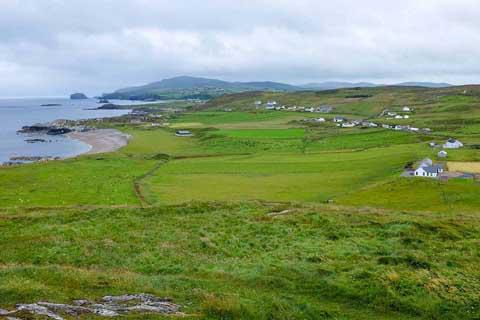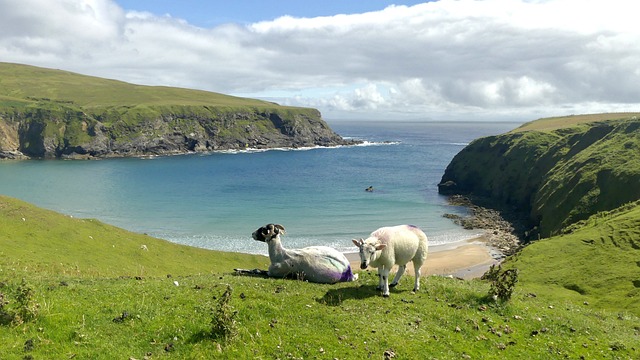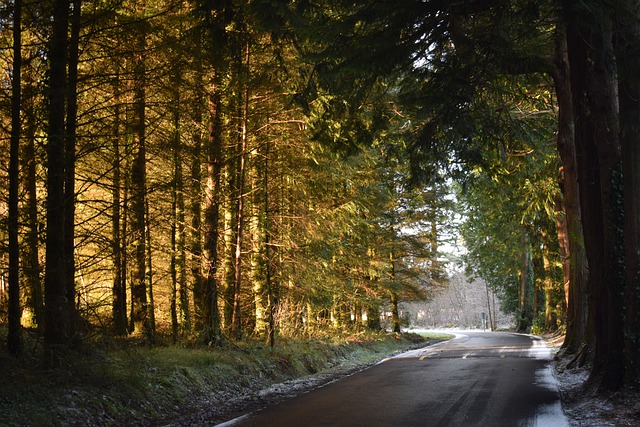Traveling in County Donegal
 Donegal Coast
Donegal Coast
Bordering the Atlantic Ocean on Northern Ireland's northwestern perimeter, County Donegal is a largely Irish-speaking region known for its castles, rugged coastline, and scenic mountain landscape. Until around 1600, the area was largely controlled by the O'Donnel clan, one of Ireland's richest and most powerful Gaelic ruling families. Their base was located in what is now Donegal Town at Donegal Castle, which still stands today.
Like many areas on the western seaboard of Ireland, Donegal has a world renowned fiddle tradition with songs featuring a distinctive sound that can be heard in just about any village pub. It also has a long literary tradition, beautiful wool textiles, and a largely Catholic population.
Regions
Donegal Town, home to Donegal Castle, is the place that gives County Donegal its name. It is a quaint town with a handful of pubs and inns, and offers easy access to sandy beaches as well as hiking in the nearby Bluestack Mountains. While the pubs do have some nightly traditional entertainment, a better selection of shops and social amenities can be found in other nearby towns.
Letterkenny, for example, is the largest and most populous urban settlement in County Donegal. The town boasts a movie theater, annual music festivals, as well as a lively nightlife with many bars, pubs, and clubs to choose from.
If you seek more of a quaint, but bustling village, Ardara is becoming more and more popular with visitors. There has been some recent growth with pubs and shops featuring local crafts made from wool-as it is the woolen center of County Donegal. There is also a weaving museum, plus music, dance, and art festivals throughout the year.
Bundoran is the most southerly town in County Donegal. A popular seaside resort, the town caters primarily to tourism with a large selection of inns, pubs, and local activities.
Related:
Traveling alone to Dublin or London?
Looking for a party and need a hostel in London or Amsterdam?

 People travel to County Donegal in droves to relax on the stunning beaches. There are sandy beaches and beautiful stretches of coastline to explore. Some of the top beaches in the county include Ballymastocker Bay, Portnoo Beach, and Fintra Bay.
People travel to County Donegal in droves to relax on the stunning beaches. There are sandy beaches and beautiful stretches of coastline to explore. Some of the top beaches in the county include Ballymastocker Bay, Portnoo Beach, and Fintra Bay. Discovering the hiking trails around County Donegal is a delight. The dramatic coastline, beautiful seaside cliffs, and beautiful mountains all offer a beautiful backdrop for hiking. Some of the best hikes in the county include the Inishowen Head Loop, Tory Island Loop, and the Garden Trail in Glenveagh National Park.
Discovering the hiking trails around County Donegal is a delight. The dramatic coastline, beautiful seaside cliffs, and beautiful mountains all offer a beautiful backdrop for hiking. Some of the best hikes in the county include the Inishowen Head Loop, Tory Island Loop, and the Garden Trail in Glenveagh National Park. Budget Your Trip is all about finding out how much everything costs so that you can travel cheaper and longer. Created by avid travelers Laurie and Bryan, our goal is to help you plan your next trip on the right budget. With average daily travel costs that are calculated from the budgets of real travelers, plus an analysis of hotel and tour prices, you can find out how much money you need to plan your next adventure. We also have plenty of travel advice, accommodation reviews, and activity suggestions.
Budget Your Trip is all about finding out how much everything costs so that you can travel cheaper and longer. Created by avid travelers Laurie and Bryan, our goal is to help you plan your next trip on the right budget. With average daily travel costs that are calculated from the budgets of real travelers, plus an analysis of hotel and tour prices, you can find out how much money you need to plan your next adventure. We also have plenty of travel advice, accommodation reviews, and activity suggestions.